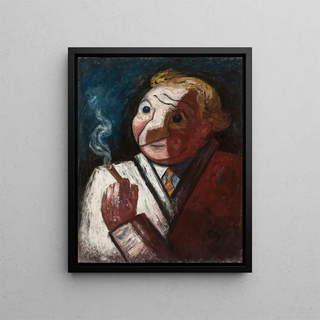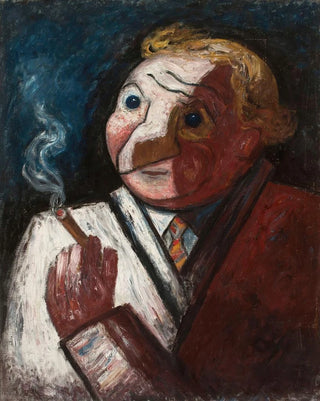Art print | L'homme au cigare Stéphane Manier - Tadeusz Makowski


View from behind

Frame (optional)
At the heart of the early 20th-century artistic universe, "L'homme au cigare Stéphane Manier" by Tadeusz Makowski stands out for its elegance and psychological depth. This artwork, depicting a man deep in thought, enveloped in an atmosphere of mystery, invites the viewer to reflect on human nature and social relationships. The art print of this iconic piece allows for an appreciation not only of Makowski's talent but also of the richness of emotions he manages to convey through his art, revealing the subtleties of a rapidly changing era.
Style and uniqueness of the work
Makowski, with his distinctive style, combines a palette of vibrant colors with stylized forms to create an ambiance that is both warm and intriguing. In "L'homme au cigare Stéphane Manier," the shades of brown and gold, paired with touches of light, give the scene an intimate atmosphere. The artist excels in rendering textures, making the material of the cigar almost tangible, while playing with shadows to emphasize the features of the character's face. Every detail, from the fold of his shirt to the expression in his eyes, demonstrates technical mastery and artistic sensitivity that captivate the viewer. This painting does not merely depict a figure; it tells a story, that of a man lost in his thoughts, an invitation to explore the twists and turns of his mind.
The artist and his influence
Tadeusz Makowski, born in Poland, established himself on the European art scene thanks to his innovative approach and his ability to transcend the conventions of his time. Influenced by the expressionist movement, he integrated elements of Polish culture while embracing the Parisian influences that marked his era. His work is often characterized by a tension between joy and melancholy, a duality that is reflected in "L'homme au cigare Stéphane Manier." By exploring themes of identity and introspection, Makowski paved the way for a new perception of art, where each painting becomes a window into the human soul. His legacy endures, inspiring many contemporary artists.

Matte finish

View from behind

Frame (optional)
At the heart of the early 20th-century artistic universe, "L'homme au cigare Stéphane Manier" by Tadeusz Makowski stands out for its elegance and psychological depth. This artwork, depicting a man deep in thought, enveloped in an atmosphere of mystery, invites the viewer to reflect on human nature and social relationships. The art print of this iconic piece allows for an appreciation not only of Makowski's talent but also of the richness of emotions he manages to convey through his art, revealing the subtleties of a rapidly changing era.
Style and uniqueness of the work
Makowski, with his distinctive style, combines a palette of vibrant colors with stylized forms to create an ambiance that is both warm and intriguing. In "L'homme au cigare Stéphane Manier," the shades of brown and gold, paired with touches of light, give the scene an intimate atmosphere. The artist excels in rendering textures, making the material of the cigar almost tangible, while playing with shadows to emphasize the features of the character's face. Every detail, from the fold of his shirt to the expression in his eyes, demonstrates technical mastery and artistic sensitivity that captivate the viewer. This painting does not merely depict a figure; it tells a story, that of a man lost in his thoughts, an invitation to explore the twists and turns of his mind.
The artist and his influence
Tadeusz Makowski, born in Poland, established himself on the European art scene thanks to his innovative approach and his ability to transcend the conventions of his time. Influenced by the expressionist movement, he integrated elements of Polish culture while embracing the Parisian influences that marked his era. His work is often characterized by a tension between joy and melancholy, a duality that is reflected in "L'homme au cigare Stéphane Manier." By exploring themes of identity and introspection, Makowski paved the way for a new perception of art, where each painting becomes a window into the human soul. His legacy endures, inspiring many contemporary artists.






